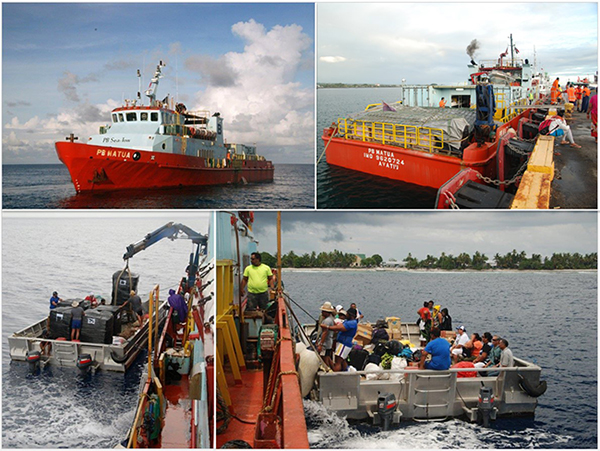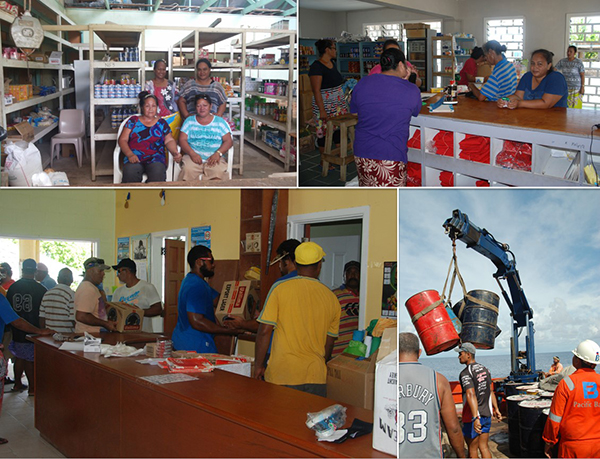Tokelau imports of foods, alcohol, cigarettes and fuel from Samoa
In 2015, the Tokelau National Statistics Office completed a study that analysed imports during 2014 into Tokelau by the co-operative and bulk stores (of which there is one on each atoll). The report provides a fascinating insight into consumption patters of the inhabitants of the atolls Atafu, Nukunonu and Fakaofo in 2014.
The contents of the report were released for general use by the Council, at a meeting in November 2015. Aggregate data for Tokelau are presented, while atoll-specific data are confidential to taupulega (village councils) to preserve the anonymity of the villagers.
The abstract follows below the pictures; the full paper minus some appendices is attached as pdf file:
Analysing 2014 imports from Samoa by Tokelau’s co-operative and bulk stores, by Jaap ('iapi') Jasperse, September 2015 (pdf, 2.0MB). (Embargo on aggregate data removed November 2015.)

Shipping goods from Apia, Samoa on the PV Matua and offloading into a barge at Nukunonu (2014/15)
ABSTRACT: This project analyses for the first time the invoices incurred in 2014 by the Tokelau co-operative and bulk stores. Each Tokelau atoll has only one of these stores: in Atafu, Nukunonu and Fakaofo. The initial aim was to get an idea of the volume of financial transactions between Tokelau and Samoa. Initial analysis of the detailed stores data showed imports from Samoa by the combined Tokelau stores amount to an average of NZ$432,000 per month, or NZ$5.2 million per annum.
Individual purchased items were coded using the international Classification of Individual Consumption According to Purpose (COICOP ). A national list had been developed simultaneously for the Household and Expenditure Survey (HIES) that is currently taking place for the first time in Tokelau. Groups of commodities could be summarised, nett volumes and weights calculated, and characteristics of the Tokelauans’ purchasing behaviour commented on.
Fuel purchased by the stores is discussed in relation to specific atoll needs and policies.
Some foodstuffs are paid attention to in relation to diet, and the top food imports are ranked.
Major areas of concern are the purchases of cigarettes and alcoholic drinks in relation to the known population aged 15 years and over. The observed consumption is explained in relation to different Taupulega (village council) policies.
Finally, products and packaging with an environmental concern in the Pacific are quantified.
Tokelau presents a unique situation in that most purchases go through the one co-op or single bulk store on each atoll. However, the figures presented do not capture the full basket of goods and services consumed. For example, there is no record in the invoices of trading in clothes, bread, and fresh fruit. Also missing are larger articles such as fridge-freezers and motor vehicles. These items tend to be parallel-imported directly by the villagers and do not feature in local stores’ data.
Suggestions for further development of this analysis are given. Justification for repeating the analysis in 2016 is provided. The work contributes towards the development of regular International Merchandise Trade Statistics (IMTS) for Tokelau, which to date have been unavailable.

Pictured: Co-operative stores in Atafu (top left), Fakaofo (top right), and Nukunonu (bottom left); and offloading fuel.
The contents of the report were released for general use by the Council, at a meeting in November 2015. Aggregate data for Tokelau are presented, while atoll-specific data are confidential to taupulega (village councils) to preserve the anonymity of the villagers.
The abstract follows below the pictures; the full paper minus some appendices is attached as pdf file:
Analysing 2014 imports from Samoa by Tokelau’s co-operative and bulk stores, by Jaap ('iapi') Jasperse, September 2015 (pdf, 2.0MB). (Embargo on aggregate data removed November 2015.)

Shipping goods from Apia, Samoa on the PV Matua and offloading into a barge at Nukunonu (2014/15)
ABSTRACT: This project analyses for the first time the invoices incurred in 2014 by the Tokelau co-operative and bulk stores. Each Tokelau atoll has only one of these stores: in Atafu, Nukunonu and Fakaofo. The initial aim was to get an idea of the volume of financial transactions between Tokelau and Samoa. Initial analysis of the detailed stores data showed imports from Samoa by the combined Tokelau stores amount to an average of NZ$432,000 per month, or NZ$5.2 million per annum.
Individual purchased items were coded using the international Classification of Individual Consumption According to Purpose (COICOP ). A national list had been developed simultaneously for the Household and Expenditure Survey (HIES) that is currently taking place for the first time in Tokelau. Groups of commodities could be summarised, nett volumes and weights calculated, and characteristics of the Tokelauans’ purchasing behaviour commented on.
Fuel purchased by the stores is discussed in relation to specific atoll needs and policies.
Some foodstuffs are paid attention to in relation to diet, and the top food imports are ranked.
Major areas of concern are the purchases of cigarettes and alcoholic drinks in relation to the known population aged 15 years and over. The observed consumption is explained in relation to different Taupulega (village council) policies.
Finally, products and packaging with an environmental concern in the Pacific are quantified.
Tokelau presents a unique situation in that most purchases go through the one co-op or single bulk store on each atoll. However, the figures presented do not capture the full basket of goods and services consumed. For example, there is no record in the invoices of trading in clothes, bread, and fresh fruit. Also missing are larger articles such as fridge-freezers and motor vehicles. These items tend to be parallel-imported directly by the villagers and do not feature in local stores’ data.
Suggestions for further development of this analysis are given. Justification for repeating the analysis in 2016 is provided. The work contributes towards the development of regular International Merchandise Trade Statistics (IMTS) for Tokelau, which to date have been unavailable.

Pictured: Co-operative stores in Atafu (top left), Fakaofo (top right), and Nukunonu (bottom left); and offloading fuel.
A study covering similar ground was previously conducted by a team sponsored by WHO. Their report is available on the AUT website, with the following caveat: "This report is for the 112 manifests that were available at the time of preparation. Consequently there has been communication that this data was incomplete and some assumptions revised – however the report still has validity concerning the types of foods, nutrition analysis and relative quantities imported into Tokelau": Rush, E; Pearce, L, Drewnowski, A (2013, Revised October 2015) Foods imported into the Tokelau Islands, 10th May 2008 to 1 April 2012. A report prepared for the World Health Organisation (Western Pacific Region). (pdf, 600 KB) However, the Tokelau National Statistics Office continues to have serious concerns about this paper because it contains errors of data collection, analysis and interpretation. These concerns are expressed in an appendix to the above TNSO report. While this WHO-sponsored study remains on-line, it is only fair that its limitations are accessible at the same time. Postscript to Jasperse (2015): An evaluation of Rush, Pearce and Drewnowski (2013) - pdf, 550KB The review concludes: "Under no circumstance should the 2013 report as it stands be used as a basis for policy development or for formal publication in the scientific/medical literature." |
